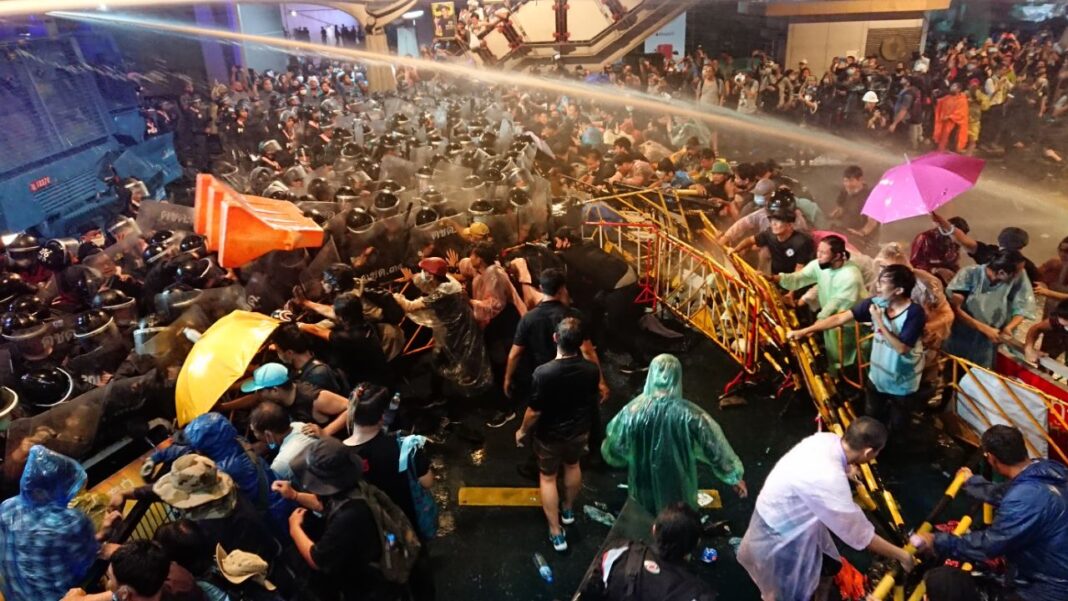THAILAND. Bangkok. Pro-democracy protesters are escalating their movement after a state of emergency was declared following a confrontation between protesters and a royal motorcade.
After three months of calling for Prime Minister Prayut Chan-o-cha’s resignation, a new constitution, and monarchy reform. The state started to respond.
13 Oct: First confrontation, arrests made
A day before a scheduled demonstration at the Democracy Monument, several protesters from the Northeastern part of Thailand showed up to organize a small protest. 21 protesters were arrested that day.
As the King’s motorcade was scheduled to pass by that area, one of the protesters announced that they would be doing a three-finger salute sign while the motorcade was passing by. The police asked the crowd to disperse, but protesters said they had the right to peacefully assemble.
The motorcade passed by around 5:30 p.m., as Prachatai reported, remaining protesters stood at the side while doing a three-finger salute and chanting “bring our friends back.”
Following the incident, BBC Thai reported that protesters moved from the Democracy Monument to gather in front of the Royal Thai Police Headquarters. Around 500 people demanded the release of 21 protesters.
Meanwhile, BBC Thai also reported that the King, his daughters, and the Queen came out from the Grand Palace to greet their supporters after the memorial ceremony of the late King Rama 9 who passed away four years ago.
14 Oct: Yellow-shirt group, occupying Democracy Monument, marching to Government House, confronting with the Queen’s motorcade
Starting at 8 a.m., pro-democracy protesters started to gather at the Democracy Monument as scheduled, they announced before that they had no intention of obstructing the royal motorcade as one was scheduled to pass Ratchadamnoen Avenue, the site of the protest.
Thai Lawyers for Human Rights (TLHR) reported that around 1,000 people with the police haircut wearing yellow shirts were around the area; yellow is known as the King’s color in Thailand. While the social media spotted many yellow-shirted people being brought to the site by the government’s trucks, local media reported that many of them were ordered to greet the royal motorcade. According to the Bangkok Insight, there were some clashes between the two groups, but they were minor.
Before they marched to the Government House around 2 p.m., protesters entered the Democracy Monument area. They cleared out the garden and seized the area.
While protesters were walking to the Government House and facing several police obstructions, some protesters were already at the destination where the Queen and Prince Dipangkorn Rasmijoti’s motorcade passed by. Protesters were yelling at them while demanding the release of other protesters, according to BBC Thai.
This prompted responses from the Prime Minister as his spokesperson said he ordered the police to press charges against protesters who obstructed the motorcade, according to Thai PBS. He said the protest was disruptive and undermining the governance and the happiness of the Thai people.
Meanwhile, protesters arrived around 7 p.m., announced that they were going to camp in front of the Government House overnight. They said they would disperse at 6 a.m. the next day.
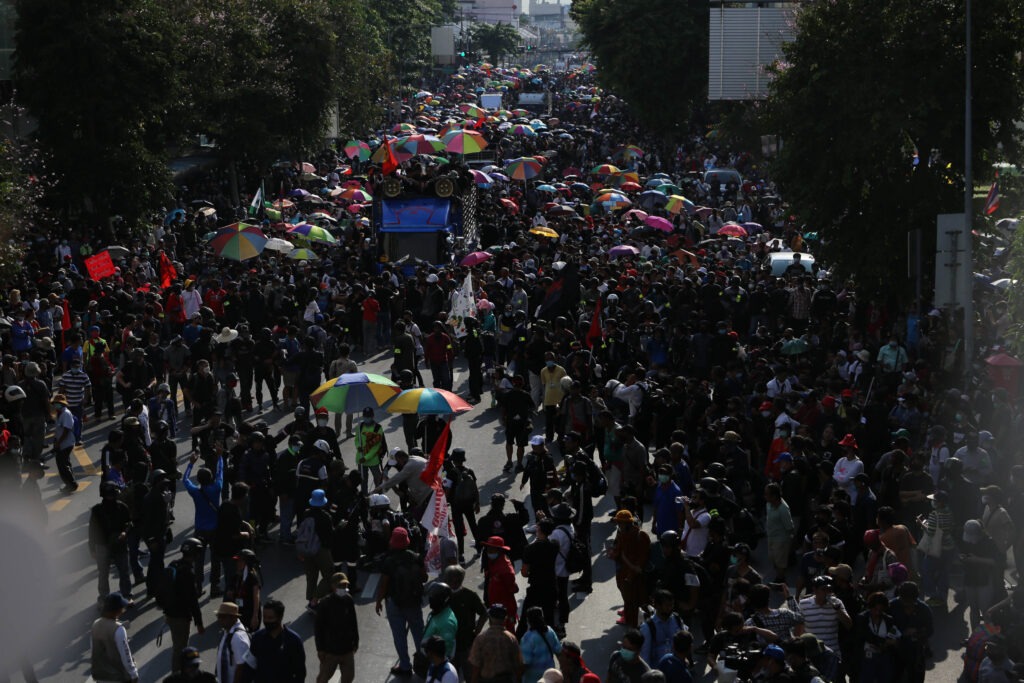
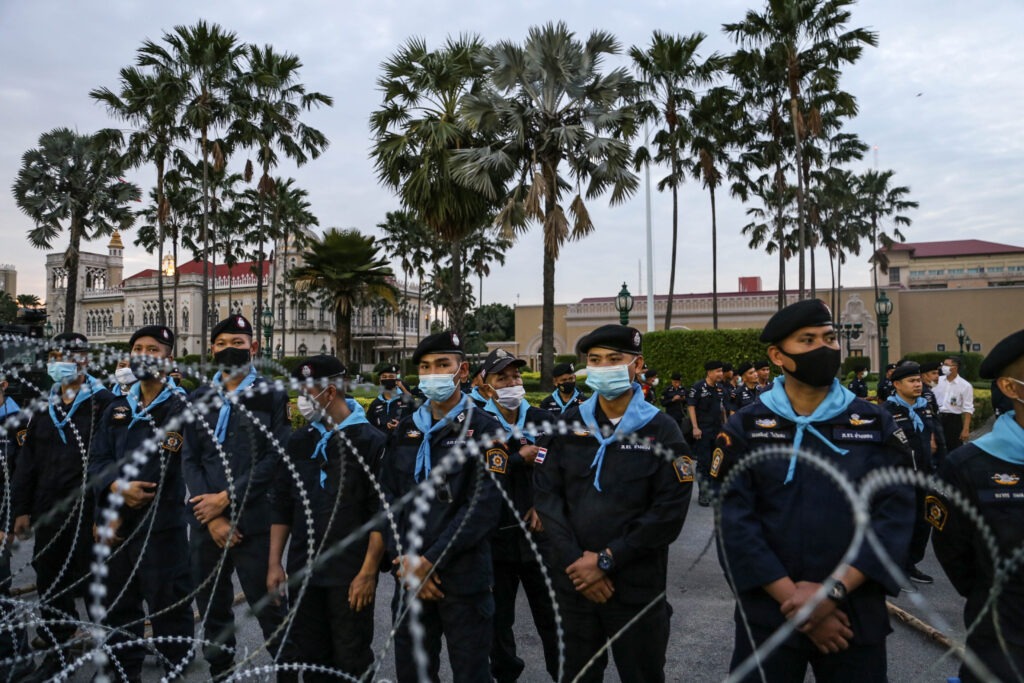
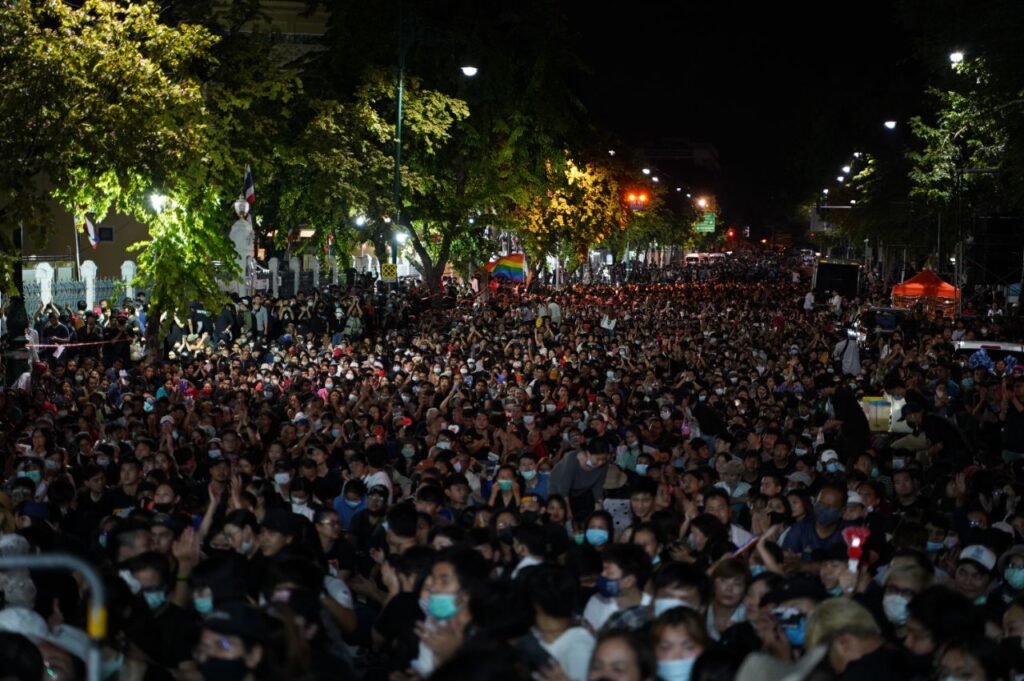
15 Oct: State of emergency, first crackdown, more arrests made, defying gathering bans
The Prime Minister imposed the “severe” state of emergency in Bangkok at 4 a.m. citing illegal protests, civil unrest, the motorcade incident, and national security. According to iLaw, the Emergency Decree allows the authorities to arrest and detain, summon individuals for questioning, seize communicating devices, search and destroy premises, and ban gatherings of more than five people. It was also reported that people who post their photos at any protest site can face up to two years in jail and up to 40,000 Baht fine.
After the Emergency Decree was put in place, the Associated Press (AP) reported that riot police started to disperse the protesters. Around 20 protesters, including the organizers, were arrested.
Protest leaders called for another protest at Ratchaprasong intersection where many top shopping malls are located, at 4 p.m. despite the ban.
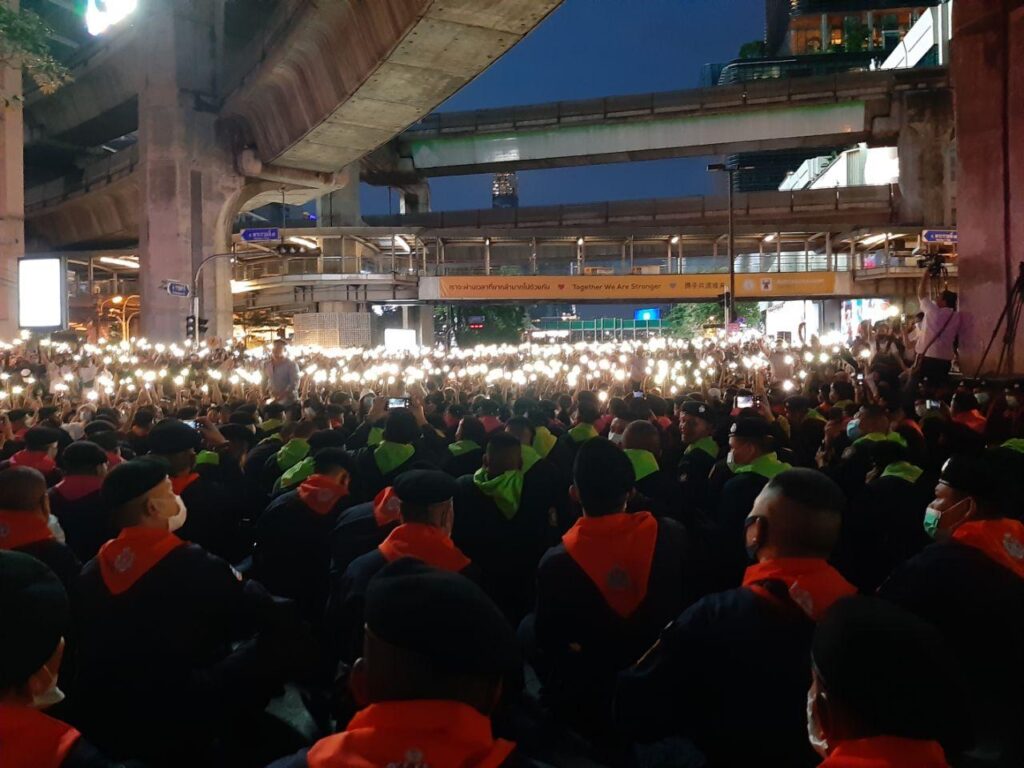
Throughout the day, many protest leaders were arrested, charged with sedition and violation of the Emergency Decree, and imprisoned.
While the opposition parties opposed the decree’s imposition, Matichon reported that over 100 military personnel were stationed at The Parliament.
Even though the police discouraged people from gathering, thousands of people showed up. Shopping malls nearby, including Central World, closed early. There were some clashes as protesters broke the police lines to occupy the area.
Similar protests broke out in Chiang Mai, Uttaradit, and Chonburi, according to Prachatai. They demanded the release of “their friends.”
Police said they would be dispersing the protesters at 6 p.m., but it did not happen. Protesters ended their rally at 10 p.m. before announcing that they would come back the next day at 5 p.m.
16 Oct: Violence against The Queen charges, violent crackdown, water cannons and chemical substances used
ThaiRath reported that two protesters, Ekkachai Hongkangwan and Bunkhueang Paothong, were arrested with charges of committing an act of violence against the Queen (Section 110). The warrant came after the incident on 14 Oct. They can face 6-20 years in prison or life sentences. Paothong was released on bail but Hongkangwan did not request bail so he was imprisoned.
As the protest was scheduled at the same location at 5 p.m., local media reported that police took control of the area by closing the traffic at the intersection by 3 p.m. As a result, protesters moved the site to Pathumwan intersection, which is about 1 kilometer away.
All public transportation near the intersection was suspended— several BTS train stations were closed, an express boat pier nearby was blocked, and buses and vans were not allowed in 5 kilometers distance.
Around two hours into the protest, riot police lined up in front of the protesters while demanding they disperse. After protesters refused, the police started to use water cannons in an attempt to take control of the area. Protesters used umbrellas to form a wall to protect themselves.
Prachatai reported that high-pressure-blue-colored water infused with chemical substances was shot into the crowds, Long Range Acoustic Device (LRAD), and teargas were used. Protesters started to disperse. Police arrested over 100 people and one of them was Prachatai’s reporter.
BBC Thai reported that Chulalongkorn University, which is in the area, opened its doors as a safe spot for the protesters.
Opposition parties, netizens, and international organizations condemned the government crackdown.
The authorities said their dispersion was according to the international standard.
Meanwhile, the palace released a pre-recorded tape of the King’s speech about the country’s need for patriots and monarchists.
Earlier before the protest, the Prime Minister refused to resign. He extended the Emergency Decree until 13 Nov.
17-18 Oct: Traffic shutdown, several protest sites across the country
The protest networks did not reveal the protest site for the day, but they asked protesters to stand by at all skytrain stations at 3 p.m. so they could be ready to travel to the site upon announcement while telling protesters to protest at the stations in case of closure.
Before that happened, all the MRT and BTS stations were closed. PPTV reported that police closed many intersections and streets across Bangkok.
Protest on 17 Oct. took place around Bangkok with three main spots at Ladprao intersection, Wongwian Yai, and Udomsuk. Along with these three sites, protesters gathered throughout the city as well as 17 other provinces.
Similar tactics were used on 18 Oct. The main protest site in Bangkok was at the Victory Monument. Over 20 other places across the country hosted protests as well. Despite the gathering ban, several thousands of people came out after two about an hour of the site’s announcement on both days to defy the imposition.
There were no police obstructions as protesters dispersed several hours into the protests.
Protesters repeated their three demands: the Prime Minister’s resignation, a new constitution, and monarchy reform.

